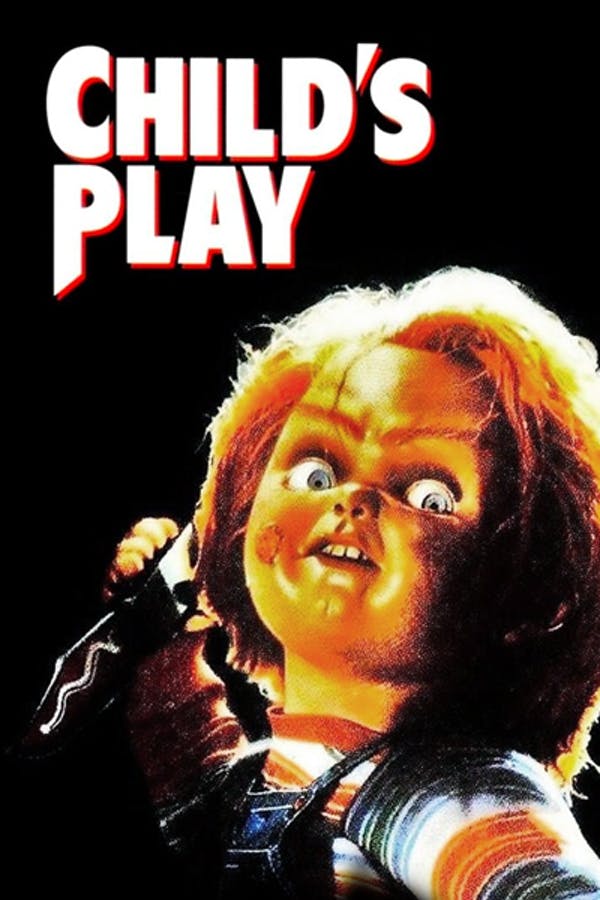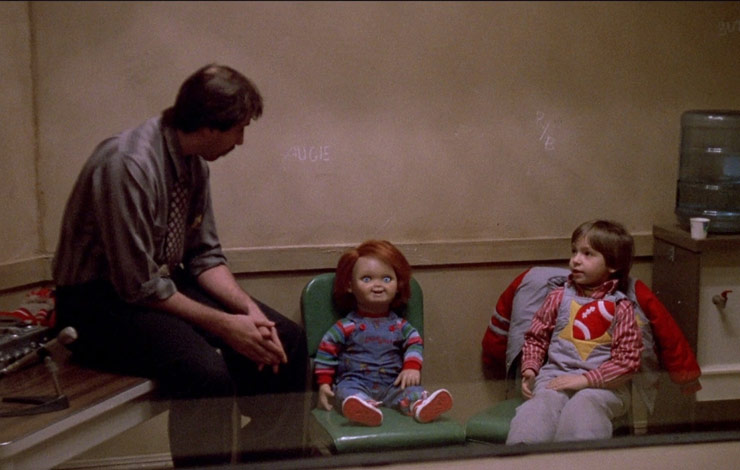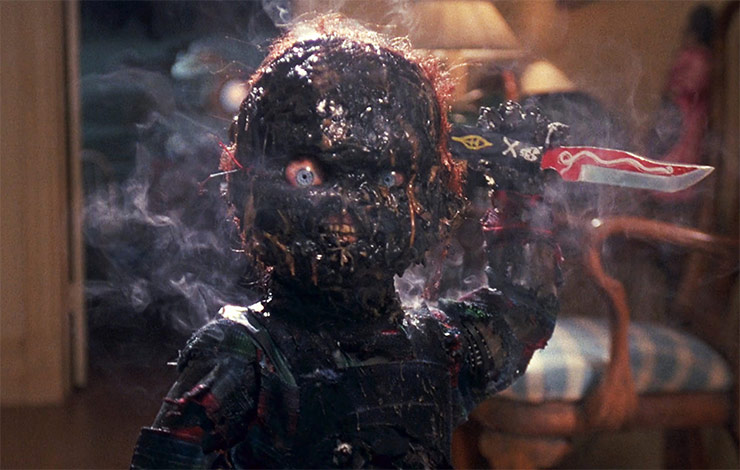

“Hi, I’m Chucky. Wanna play?”
I wasn’t expecting to connect with Child’s Play because I don’t experience pediophobia. I just don’t really find dolls to be that creepy. I do, however, love me a good campy slasher. And when the antagonist happens to be a doll that is indwelled by the vengeful spirit of a ruthless serial killer looking for some payback then I can definitely get on board. Inspired by Hasbro’s My Buddy dolls, the mascot of Child’s Play and the franchise it spawned is a carrot-topped, blue-eyed, puffy-cheeked demon named Chucky. You’ve probably heard of him. The character has transcended the films, his name and catchphrase holding serve on the periphery of the pop culture lexicon, but a cursory glance at IMDB ratings indicates that the rash of sequels was not as warmly received as the first film. While series’ mastermind Don Mancini has regularly reinvented his star children’s toy to mixed results, Tom Holland’s original remains an effective horror film, squeezing some good scares and tasty kitsch out of its hokey premise and featuring incredible effects.
In the prologue we watch the mortally wounded Charles Lee Ray (Brad Dourif) stumble his way into a toy store, perform a voodoo ritual to transfer his soul into a Good Guy doll, and call lightning down upon the premises. Meanwhile, little Andy (Alex Vincent) has fallen victim to child marketing. He fixes a bowl of Good Guy cereal, watches Good Guy cartoons, and even dresses like Good Guy. His spineless mother Karen (Catherine Hicks) cannot resist his pleas for his very own Good Guy doll. She’s a single parent trying to make ends meet, so instead of ponying up a hundred dollars for a nice new doll she barters with a homeless peddler behind her workplace for one that he pulled out of the smoldering ruins of the toy store.
Chucky makes his first kill pretty directly, chucking (ha!) a claw hammer at Karen’s best friend Maggie (Dinah Manoff) while she’s babysitting Andy. The projectile bludgeon conks her on the head and causes her to stumble backwards through the upper story apartment window and fall to her death on the street below. Andy becomes a suspect, doubly so when he is found near the scene of an explosion that kills Charles Lee Ray’s former accomplice the next day.

Chucky doesn’t truly “come alive” on the screen until about halfway through the film. Up until this point, Andy’s the only one who has seen him move around (and lived to tell of it). This is neat because not only does it mean the killer is hiding in plain sight, but also that many scenes could be shot with a legitimately lifeless, non-animated doll. (And Holland clearly agrees with me that dolls aren’t inherently scary, by the way, because the adults treat this creepy-looking plastic toy nonchalantly, hauling him around by his limbs, whacking his head off of furniture. Anyway.) Eventually, Karen discovers that Chucky has been operating without batteries this whole time and tries to verify her son’s claims that Chucky is alive. She gets a roaring fire going and is about to thrust the doll into the flames when Brad Dourif’s savage voice screams profanities at her and Chucky attacks. Then it’s Detective Norris’s (Chris Sarandon) turn to doubt Karen’s story, until he too witnesses the evil antics of Chucky in action.

The animation is superbly well done through the variable use of child actors, puppeteers, radio-controlled animatronics, cosmetics, and sneaky editing. I may think that dolls are not inherently creepy, but this one definitely gets the job done, in large part because so much is achieved through practical means. But like nearly every horror villain, the unseen threat of Chucky is much scarier than his realization on screen. The thing is, no one expects the doll to be animate—of course, right?—so his presence is like Hitchcock’s bomb under the table. We know that lifeless object is actually a serial killer, but they don’t. If they knew the stiff-legged midget would be coming after them with a knife they’d just dropkick his head clean off and that would be the end of it. It’s not like there’s a swarm of them. There’s just one Chucky, so once he’s exposed he should be a piece of cake. Unfortunately, Child’s Play follows a formula that needs a climactic showdown at the end. We get one but it’s very underwhelming because of how silly it seems when set against the suspenseful early scenes, even if some of the best effects work occurs during this sequence as Chucky keeps advancing like a demonic combination of the Black Knight and the Terminator.
But aside from that letdown, Child’s Play works quite well. It’s a testament to Holland’s skill that he’s able to wring some legitimate tension out of such a hammy premise. He proves extremely capable at directing action scenes, particularly the one in which Chucky stabs at Detective Norris through the seat of his car while he drives at high speeds. He does a great job coaxing a wonderful performance out of a seven year old (who gets to cuss and gets knocked out with a baseball bat, no less). Dourif’s great voice work elevates Chucky from a goofy throwaway villain to a wisecracking terror akin to Freddy Kruger, a sassy alternative to the silent brutalizers that dominate the genre. With its steady doses of campy comedy, solid effects work, and light touches of social commentary, Child’s Play is a delectable little 1980s horror-comedy/slasher hybrid. The film as a whole is not quite as iconic as some other classics of the era, but it works perfectly as scaffolding for its villain to take his place among the pantheon.
Sources:
Rossen, Jake. “Your Friend ‘Til the End: An Oral History of Child’s Play”. Mental Floss. 19 June 2019.